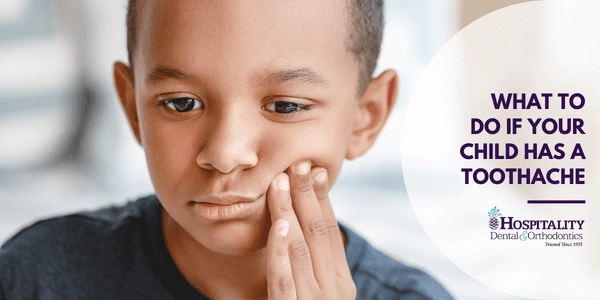
How can I help a child with a toothache? This is a question many parents find themselves asking, and few things are more difficult for a parent than feeling helpless to stop their child’s pain. But before the problem of big pain from a small tooth can be solved, it’s useful to understand what could cause a toddler toothache.
Common Causes for a Child’s Toothache
Dental Decay and Cavities: Nearly 20% of all children will experience tooth pain. The leading cause is decay and cavities – also known as “caries” in medical circles. This painful condition is often the result of corrosive bacteria that can build up when you drink sugary drinks or fail to clean your teeth well.
Gum Disease: The earliest stages of gum disease, also known as gingivitis, can cause painful tenderness and inflammation in your gums. This pain can then radiate to the surrounding teeth, making brushing and flossing particularly sensitive tasks.
Dental Trauma: A chipped, cracked, or broken tooth can expose the inner layers, leading to pain and sensitivity. In fact, an injury to any part of the face can cause pain to spread to the teeth.
Food Impaction: When food debris gets stuck in the teeth or gums, the surrounding tissues can quickly become irritated and inflamed. Sticky and fiber-filled foods are common culprits.
Tooth Abscess: When a cavity or other mouth infection goes untreated, the damage can extend deep into the tooth’s pulp. This can lead to an abscess, a painful pocket of puss. A child with a toothache due to an abscess must be treated immediately by a medical professional.
Tooth Eruption: Cavities, gingivitis, injuries, and abscesses all require treatment, but sometimes a toddler toothache is the result of teething. It’s perfectly natural for the eruption of a new tooth to be accompanied by pressure, but it can still be painful.
Toothache Warning Signs
If your child is old enough, they can hopefully explain any tooth pain, and even point to which tooth is the source of discomfort. You can also look out for these signals that a toothache is on the way for your youngster, maybe even catching a minor annoyance before it quickly escalates into a major problem.
- Swelling in the gums
- Redness in the gums
- Redness on the cheeks
- Tooth discoloration
- Cracks or chipping
- Loose teeth
- Broken teeth
Toothache relief
If your toddler’s toothache is the result of an injury or an infection, then only medical attention is going to address the “root” cause. Still, there are some basic at-home solutions to give your little one some relief.
Flossing gets rid of leftover food particles and prevents further buildup of plaque, the cause of tooth decay.
Rinsing with saltwater can reduce inflammation and discomfort, just don’t swallow the salty solution.
Cold compresses provide relief by numbing the painful area.
Over-the-counter pain relievers can alleviate discomfort but are not a long-term solution for pain that persists.
Toothache Danger Signs
If a child with a toothache continues to feel pain after using at-home remedies, the following signs indicate the need for professional help.
- Severe or throbbing pain that interrupts their daily activities
- Fever, which could indicate an infection
- Fatigue or a marked decrease in activity
Toothache Treatment
When seeking the help of a medical professional, any of the following interventions might be necessary to stop your child’s tooth pain.
Fillings can repair damage caused by tooth decay, and stop cavities from deepening or spreading.
Root canals remove damaged or infected pulp in a tooth’s interior. The area is then filled and sealed to prevent further injury.
Tooth removal may be necessary in the most extreme cases.
Toothache Prevention
The old proverb says, “an ounce of prevention is worth a pound of care,” and the best way to treat your child’s toothache is to take steps to prevent it. While not all toothaches can be prevented, following basic oral hygiene recommendations give your family the best chances of avoiding these painful situations.
- Brush twice daily, using fluoride toothpaste once your child has reached the appropriate age.
- Floss daily to remove plaque and loose food particles.
- Limit sugary drinks that can cause tooth decay.
- Stay hydrated to limit the formation of bacteria and to wash away stray food particles.
- Regular dental checkups: Schedule biannual appointments for professional cleanings and examinations.
While the source of a child’s toothache may be invisible to the naked eye, pain prevention doesn’t have to be mysterious. In the unfortunate case that a toothache does occur, schedule an appointment so the problem can be solved as quickly as possible.
